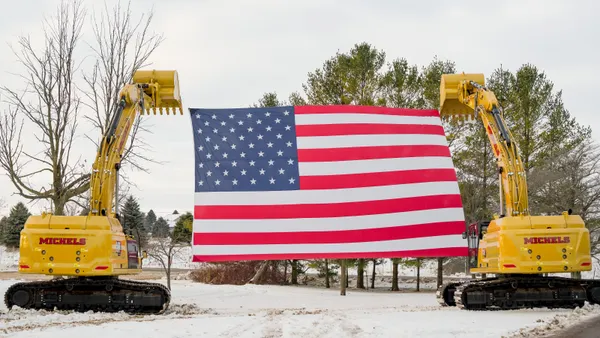Forging ties with the community and keeping an eye on the labor pool are two keys to successful manufacturing projects, experts in the space told viewers in a Construction Dive panel on May 2.
During a live event highlighting opportunities in the U.S. manufacturing construction boom for builders, three executives from large builders across the country shared their insights on not only earning these massive, multibillion-dollar contracts, but on completing them while stepping over common pitfalls along the way.
“Every project has its own personality,” said Chris Morgan, vice president of Detroit-based Walbridge’s vehicle manufacturing group.
For builders, the information could prove timely and prescient, as a surge of manufacturing megaprojects continues to crop up across the country.
“When you look across the landscape of advanced manufacturing, you have to think, ‘why is this such an explosion right now?’” said Drew Romans, vice president of manufacturing for Lexington, Kentucky-based Gray Construction. “The funding and these incentives are kick-starting this, but there's still a heavy demand out there. We expect the next few years to be pretty bright for this industry.”
Winning the job
The panelists said that each manufacturing job presents unique challenges and the process starts before a job is even won. Bidding, one expert said, has changed, and it’s no longer a cut-and-dried process.
“The old days are gone, where you send out a bid invite, and everybody shows up because they want to get your job,” Morgan said. “It takes a lot of pre-planning.”
For example, Morgan’s team at Walbridge puts together a strategic procurement plan that's adjusted to the current market and its unique conditions, while simultaneously targeting qualified and interested subcontractors.
Romans said that low bids aren’t necessarily the most attractive to clients, as owners in the advanced manufacturing space are now coming around to solution-based proposals, a change from 20 years ago. More important, he said, is whether you can get the job done on time, or even earlier, independent of price.
Erik Magsamen, vice president of industrial and manufacturing for Kansas City, Missouri-based JE Dunn, elaborated on the constant tightrope-like effort it takes to stay on track.
“We really have to work [with] very detailed, diligent budgets that make sense, where we've really thought through everything that is not on a drawing,” Magsamen told the audience.
Community relationships
Building that relationship with a client is obviously important — but just as key is building a relationship with the community where the project is located.
Magsamen said that his company would ensure, for example, that when they had meetings, they would order from local restaurants for food.
“I think the little things like that matter — having that community outreach, doing the Christmas toy drives and being part of the community. You're there for two, three, four years, and you’re a part of that community and really embracing that,” Magsamen said.
Finding staff
The big challenge, as with most sectors of construction right now, comes from finding labor, panelists said. In January, Associated Builders and Contractors predicted that the industry would need to fill 501,000 more positions, on top of the normal pace of hiring, to meet demand.
This includes manufacturing megaprojects. Morgan said that labor issues won’t curb demand, but if these problems persist, then it will certainly force the field to plateau.
To counteract these issues, Morgan emphasized that it’s important to have a labor attraction plan. Success boils down to how workers are treated — good parking lots, amenities such as break areas, clean restrooms and a site free from trash — and whether your jobsite stands out as the most attractive option.
“Sometimes we forget, they have choices too, just like subs do. Just like general contractors do. They have a choice of which job they want to come to every day, and we need to treat them right,” Morgan said.
Romans emphasized recruiting potential workers before they even enter the labor force. By meeting potential employees in schools and trade institutions, contractors can make inroads before they begin looking for their own work.
Technology is another potential solution that can allow contractors to do more with less, but contractors shouldn’t lose sight of the people using the technology in the first place, Romans said.
“You think about automation and you think about robotics and sometimes you stop thinking about the welders and pipefitters and the boots on the ground,” Romans said. “I wanted to make the point that tech and technology and all of these advancements aren't a reduction of those types of people or trades. They're really an amplifier for them.”





















